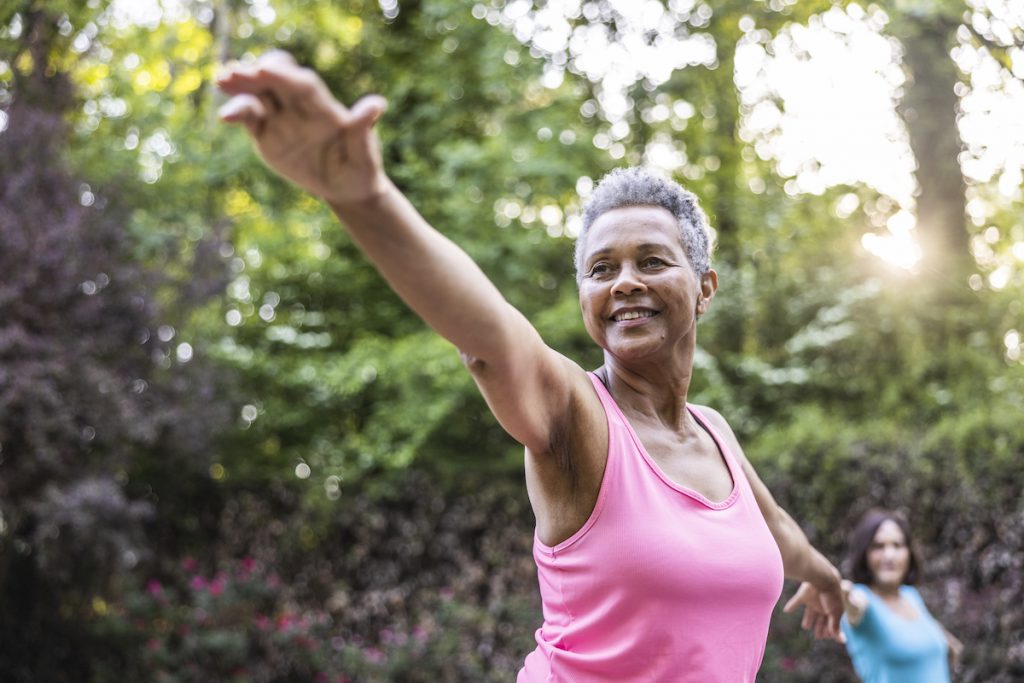Why Yoga Belongs in Your Healthy Aging Plan
Yoga is a great way to maintain mobility, balance and flexibility — three keys to staying independent as you get older. But that’s just the beginning!

Whether you’re just starting a wellness journey or you’re a lifelong athlete, yoga can be a great addition to your daily routine at any age. And for seniors, it can offer big advantages when it comes to healthy aging.
Yoga is a gentle way to boost your strength, balance, and flexibility. Plus, research shows yoga can bolster your mental health and may even help stave off some of the cognitive decline associated with aging.
Ready to roll out your mat and get started? Here’s what you need to know to make yoga part of your fitness routine.
Stay active, have fun, get fit — with SilverSneakers! Classes and events are happening right now at participating gyms, online through SilverSneakers LIVE, and at community centers near you. Activate your free online account to get started.
What is yoga?
Yoga is an ancient practice rooted in Indian philosophy. Although it has spiritual roots, yoga offers plenty of physical and emotional benefits, too. Today in the United States, yoga is primarily used as an exercise to promote general wellbeing, according to the National Institutes of Health.
A yoga session involves getting into certain postures, called poses or asanas. When these poses are strung together, it’s called a sequence.
The practice also includes breathing techniques and meditation. There are many different yoga styles, from restorative yoga to aid in stress relief to more intense styles designed to build strength and endurance.
What makes yoga different than just stretching?
You’ll definitely stretch your muscles during a yoga class. But this practice is about much more than the act of stretching itself.
Yoga puts an emphasis on deep, steady breathing, as well as movements. This type of mindful, controlled breathwork helps improve the function of the nervous system, according to Mayo Clinic.
When you breathe this way — anytime, not just during yoga — it stimulates your body’s vagus nerve. (Your vagus nerve runs from your brain to your large intestine, and it transmits information about stress and digestion.) When paired with yoga movements, this type of breathing can help you feel calmer and more present.
During a yoga class, your instructor may remind you to keep your breath steady and deep.
Yoga also places an importance on mindfulness. This means moving and breathing with intention, rather than “zoning out” during a yoga session. It also means being aware of your body and its position.
Yoga is a movement meditation, similar to a practice like tai chi, which also involves purposeful breathing combined with specific movements.
Recommended reading: Yoga for Seniors: Which Type Is Best for You?
How popular is yoga?
Although yoga has been around for centuries — its exact age is still a matter of debate — its popularity has taken off in recent decades, especially in the U.S. It’s easier than ever to find yoga classes in your neighborhood or online.
Research firm Statista estimates that about 18 million people were doing yoga regularly in the U.S. in 2008. A decade later, that number had grown to 29 million. A survey done by the Yoga Alliance, a nonprofit focused on the integrity of yoga teaching, estimates that 15% of Americans have practiced yoga in the last six months. And one in three Americans have tried yoga at least once.
What are the health benefits of yoga?
It’s no exaggeration to say yoga can benefit nearly every system in your body. Research suggests that the way yoga combines movement and deep breathing results in wide-ranging health advantages, including:
- Lower stress
- Deeper sleep
- Reduced risk of falls
- Less back pain and neck pain
- Improved weight
- Higher effectiveness of smoking cessation
- Lower incidence of hot flashes during menopause
- Better range of motion in joints
- More strength
- Relief from tension headaches
- Improved immune response
- Better posture
- Lowered blood pressure
Does yoga have any mental health benefits?
Yoga’s health benefits go far beyond improving your physical strength. Research suggests it may also help boost your emotional resilience.
Yoga has been shown to reduce symptoms of anxiety and depression. The effect is so pronounced that some mental health experts have suggested using yoga as a complement to depression treatment, depending on the severity of the condition. It is believed that the combination of movement, relaxation, breathing regulation, and meditation is what helps alleviate the symptoms of anxiety and depression.
How does yoga help with balance?
When you think about boosting your balance through yoga, you might imagine poses that have you standing on one foot.
If that sounds intimidating, you can breathe a sigh of relief knowing that yoga can help build your balance in more subtle ways. In fact, yoga can improve your balance even if you don’t do a single pose that challenges your stability.
Balance comprises three main components, according to Mayo Clinic:
- The ability to feel how your body is moving in a space, also called proprioception.
- Visual perception, especially in terms of how you navigate that space using your vision.
- The inner ear, or vestibular system, which provides information to the brain about your equilibrium.
These three components work together to control static balance (when you’re standing still) and dynamic balance (when you’re moving). Yoga can play a role in optimizing all three factors, particularly proprioception and vision.
Moving between unfamiliar poses can train you to shift dynamically without support from an external object, like a chair. Those types of exercises have been shown to build balance, increase confidence, and reduce the risk of falls.
Can you still do yoga with mobility limitations or chronic conditions?
Absolutely! Because of the wide range of yoga styles, there is a practice for everyone.
Chair yoga is done primarily seated, with some standing poses that involve holding the back of a chair for support. This style is ideal for people who use assistive devices to walk, as well as those who are recovering from an injury or living with arthritis.
If you have a chronic condition such as cardiovascular disease, a gentle yoga class can help you maintain independence and boost your overall health. Yoga may help lower blood cholesterol, blood sugar levels, and your heart rate. And by relaxing your body and mind, yoga can help ease the worry and depression that follow a cardiac event, according to Johns Hopkins Medicine.
SilverSneakers Yoga includes seated and standing poses that meet a variety of fitness levels. It’s offered both in-person at participating gyms and online with SilverSneakers LIVE.
Recommended FREE SilverSneakers On-Demand Class: Chair Yoga for Seniors
Do I need special equipment for doing yoga?
The short answer: Not necessarily. Most yoga poses are done with just your bodyweight, so you don’t need anything besides yourself to get started. But some pieces of equipment may prove useful.
If you do decide to invest in yoga equipment, a mat should be at the top of your list. Widely available, these mats can provide a little cushioning between you and the floor. But their main purpose is to help you hold poses without slipping. That can help you get into a pose and hold it with more confidence, knowing your feet are “rooted” to the mat thanks to the non-slip texture.
Tip: You don’t have to be barefoot to do yoga! In fact, sneakers are encouraged in SilverSneakers yoga classes.
Some yoga sequences use “props,” like a foam block to increase steadiness in certain poses, especially those involving balance. You can also use fabric straps that can help with stretching during certain poses.
Subscribe to our newsletter
It's quick and easy. You could be one of the 13 million people who are eligible.
Already a member? Click to discover our 15,000+ participating locations.
Follow Us
What’s a good way to get started with yoga?
The best way to get into yoga is to take a class, where you can learn from professional instructors. Be sure to get your doctor’s OK before beginning any new exercise routine.
With SilverSneakers Yoga, you can learn the basics from our specially trained instructors who understand the unique fitness needs of seniors. This class (both in-person or online with SilverSneakers LIVE) caters to all levels of skill and experience, so beginners and advanced yogis are welcome.
As you become more advanced, you may enjoy trying some of our other yoga classes on SilverSneakers LIVE, including:
- Yin Yoga (intermediate level)
- Yoga Pilates Fusion (a combination of yoga, Pilates, and barre exercises)
- Yoga Flow (advanced level)
Yoga is easy to tailor to your lifestyle. If you only have 10 minutes free, that’s enough time to try the five perfect beginning poses for seniors — including follow-along videos — here.
Or press play on the video below to try a 10-minute version of our popular SilverSneakers Yoga class:
Recommended yoga sequences:
4 Arthritis-Friendly Yoga Poses
This Quick Yoga Routine Is Also a Serious Strength Workout
Yoga Flow to Ease Tight Hips and Back
When you figure out which poses you like best, you can create an individualized sequence of all your favorite moves.
Are there any yoga poses that should be avoided?
Not every yoga pose is going to be right for you. A study looking at older people with osteoporosis found that some poses involving extreme flexing or significant spinal extension tended to worsen joint pain.
That doesn’t mean you should avoid yoga altogether. The researchers in that study suggest modifying postures to accommodate your condition. Learn more about poses that can help strengthen your bones here.
Most of all, listen to your body and dial back on the intensity if there’s pain, tightness, or something just doesn’t feel right. Yoga can be challenging, but it should never feel painful.
Once you get started, you can look forward to seeing how yoga can nourish your body and mind— and have fun along the way.
See our sources:
Staying active tips for aging: U.S. Department of Health and Human Services
Yoga for healthy aging: Advances in Geriatric Medicine and Research
Yoga basics: National Center for Complementary and Integrative Health
Yoga participation: Statista and Yoga Alliance
Health benefits of yoga: Mayo Clinic and Cleveland Clinic
Yoga for depression: Journal of Evidence-Based Complementary & Alternative Medicine
Yoga for cardiovascular disease: Johns Hopkins Medicine
Poses to avoid: Mayo Clinic Proceedings
Check Your SilverSneakers Eligibility Instantly
SilverSneakers members can go to thousands of nationwide gyms and fitness locations, plus take SilverSneakers LIVE online classes that are designed for all fitness levels and abilities. If you have a Medicare Advantage plan, it may include SilverSneakers — at no additional cost. Check your eligibility instantly here.
Already a member? Get your SilverSneakers member ID and exclusive fitness and wellness content by activating your online account here.
Not eligible for SilverSneakers? You can still get 200+ free SilverSneakers On-Demand videos and stay in touch with us by creating your online account.





